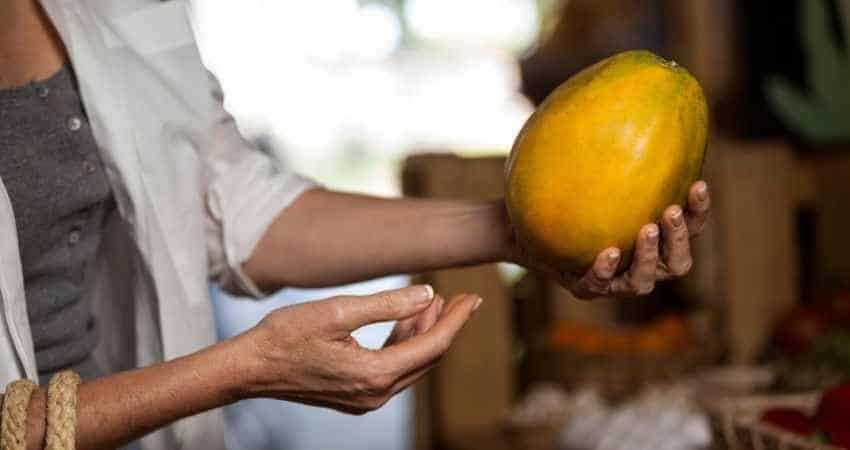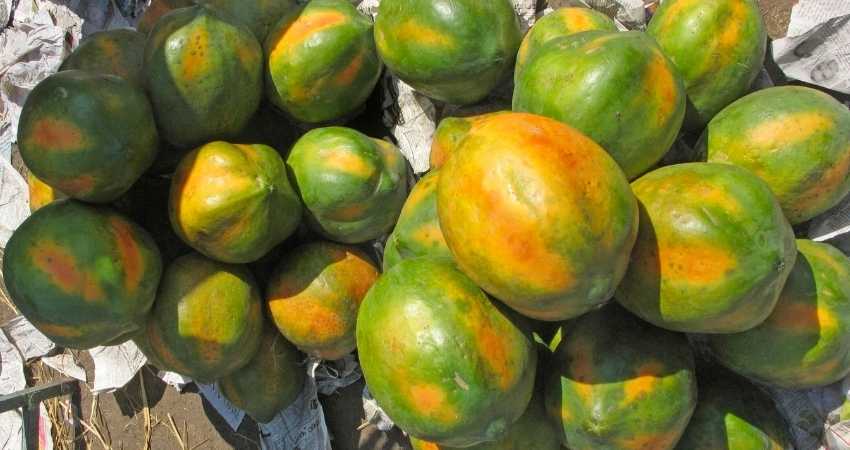4 Ways To Tell If A Papaya Has Ripened
You might be wondering how a Papaya is ripe.
It takes about 10 months for a papaya to develop on the tree and become ripe. During the ripening process, a papaya will change colors from green to yellow and grow to between 4 to 6 inches in length. While ripening a papaya feel will change firm to soft and the taste will turn from sour to sweet.
In this article, we are going to discuss the 4 easy ways for you to tell whether or not your papaya is ripe, underripe and even overripe.
Four Ways to Tell How a Papaya is Ripe

1. The Size Of The Papaya
So this is one of the least efficient ways to tell whether or not a papaya is ripe. Although it’s still important to include in this article. When papaya farmers are harvesting their fruit, many times they don’t have the luxury to inspect every single papaya. That’s up to the next stage but while being harvested, they rely a lot on the size.
A papaya will be between 4 to 6 inches in length when ripe. This differs for each papaya, but it’s one of the first ways for you to see whether or not a papaya is ripe.
The next step will be to look at the color of the fruit which is the most important part when determining whether most fruit is right.
2. The Color Of The Papaya
Luckily with most fruits, they have a clear indicator as to whether or not they are ripe. When it comes to papaya, they are no different. Papaya changes color as it ripens.
While the papaya is growing on the tree, it will be green. Once the papaya is ripe, it will have changed to a yellow color. Most of the time papaya will be picked when it’s yellow with a lot of green shading. By the time it gets to the consumer, it will be fully yellow and ready to eat.
If you have a papaya and it still has some green shading on it, it should still be fine to eat. However, if more than a third of the papaya is green.
After a papaya has ripened, it can be frozen so it can last you a long time. Find out how to do it properly and read my blog post on the topic by clicking here, The Complete Guide To Freezing Papaya.
3. The Feel Of The Papaya
Another way to judge whether or not a papaya is ripe is to feel it. Therefore, if you have a papaya, get it ready and give it the touch test while reading the section.
When a papaya is unripe, it will be hard when you press a finger into it. When a papaya is ripe and ready to eat, you will be able to easily push your finger in and make a dent in the fruit.
You’ll need to only apply a little bit of pressure because it will still be slightly firm, just easier to press and make a small indentation.
It’s important to note you should not press on the papaya too hard. All that you’re trying to do is feel whether or not it is ripe. The last thing you want to do while doing this test is to bruise the papaya.
A bruised papaya will not only look unpleasant when you remove the skin but it will also alter the taste of that area of the fruit.
How will it affect the taste? It might become a little bit bitter to the taste on the bruised sections. So make sure to use only one finger while pressing and not more.

4. The Taste Of The Papaya
So, if all else fails and you decide to just go ahead and eat the papaya, you might notice an unpleasant taste if it’s not yet ripe. On the flip side of that, if the papaya is ripe, it will give you a beautiful tropical taste that’s sweet with a beautifully soft texture.
Luckily it’s easy to test whether or not something is ripe, underripe or even overripe. As mentioned above, a ripe papaya will be sweet with a beautifully soft texture but what about if it is under or overripe? Well, let’s take a look at what it will taste like.
Underripe
When papaya is underripe, you will have a very distinct taste when eating the fruit and this is very important. So, let’s take a look at what an underripe papaya will taste like.
An underripe papaya will have a very distinct sour taste to it. This is because it still has a high acidic count. The sugar within the papaya has not had enough time to fully establish itself and influence the balance between acid and sugar.
Overripe
Now that you know what an underripe papaya will taste like, let’s look at the other side of the spectrum. Therefore, in this section we’re going to quickly discuss what an overripe papaya will taste like.
An overripe papaya will have a bitter taste to it. This is because much of its sugar has had too much time in the fruit and they have started losing their sweetness. It’s at this stage where the papaya will start to go bad.
If you have any questions about this article don’t hesitate to comment below or email us. You can find an email on our contact page.
Read Next – More Food Storage
This Is The Best Way To Store Your Olive Oil
This Is How Long You Can Keep Fresh Asparagus
